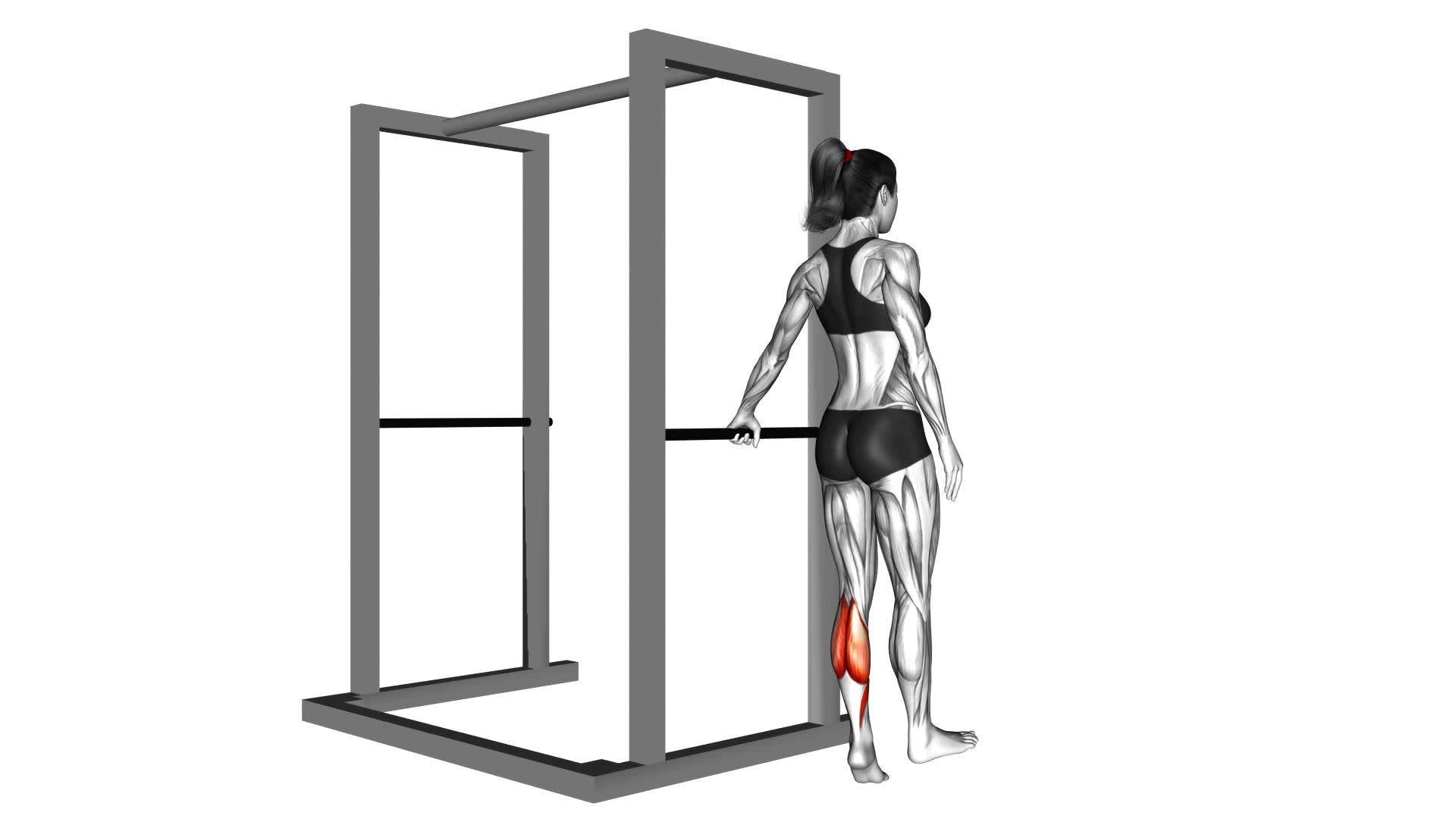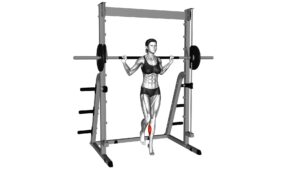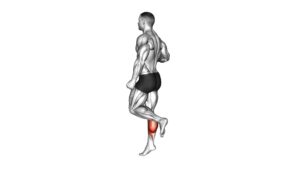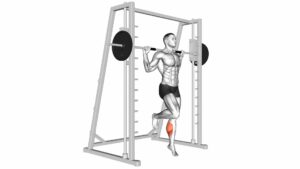One Leg Floor Calf Raise (female) – Video Exercise Guide & Tips

Want to strengthen and tone your calf muscles? Look no further than the one leg floor calf raise! In this video exercise guide, we'll show you the proper form and technique to get the most out of this exercise.
Watch This Exercise Video
Whether you're a beginner or more advanced, we'll also provide modifications and progressions to challenge yourself. Avoid common mistakes and maximize your calf workout with our helpful tips.
Get ready to feel the burn and achieve stronger, shapelier calves!
Key Takeaways
- One Leg Floor Calf Raise strengthens calf muscles
- It helps prevent calf strains and Achilles tendonitis
- It improves stability and balance
- It activates muscles in feet and ankles
Benefits of One Leg Floor Calf Raise
You can experience several benefits when performing the One Leg Floor Calf Raise exercise. This exercise isn't only great for strengthening your calves but also for injury prevention and muscle activation. By performing this exercise regularly, you can help prevent injuries such as calf strains and Achilles tendonitis.
The One Leg Floor Calf Raise targets the calf muscles, specifically the gastrocnemius and soleus, which are important for stability and balance. It also activates the muscles in your feet and ankles, improving their strength and flexibility.
In addition to injury prevention, the One Leg Floor Calf Raise also helps to activate and strengthen your calf muscles. This exercise specifically targets the calf muscles, allowing you to isolate and work them effectively. By strengthening your calves, you can improve your overall athletic performance, as well as your ability to perform other exercises and activities. Strong calf muscles are also important for activities such as running, jumping, and walking.
To perform the One Leg Floor Calf Raise with proper form and technique, it's important to maintain a straight posture throughout the exercise. Keep your core engaged and your shoulders relaxed. Start by standing on one leg with your toes on the edge of a step or a raised surface. Slowly raise your heel as high as possible, then lower it back down to the starting position. Repeat for the desired number of repetitions before switching to the other leg.
Proper Form and Technique
To ensure proper form and technique during the One Leg Floor Calf Raise exercise, it's important to maintain a straight posture and engage your core while standing on one leg with your toes on the edge of a step or raised surface. This position helps promote proper alignment and balance throughout the exercise.
Start by standing tall with your shoulders back and your chest lifted. Keep your abdominal muscles tight to engage your core. Place one foot on the edge of the step or raised surface, with the heel hanging off.
As you lift your body up onto the ball of your foot, focus on activating your calf muscles. Push through the toes, lifting your heel as high as you can. Pause at the top for a brief moment, squeezing your calf muscles.
Slowly lower your heel back down, allowing it to drop below the edge of the step or raised surface. Repeat the movement for the desired number of repetitions, then switch legs.
Remember to maintain a controlled and steady pace throughout the exercise. This will help ensure proper muscle activation and reduce the risk of injury.
Modifications and Progressions
To modify and progress the One Leg Floor Calf Raise exercise, try incorporating additional resistance or increasing the range of motion. You can use dumbbells or a weighted vest to add resistance to the exercise. Hold the dumbbells in your hands or wear the weighted vest while performing the calf raises. This will make the exercise more challenging and help to further strengthen your calf muscles.
Another way to modify the exercise is by increasing the range of motion. Instead of just raising your heel off the floor, try going up onto your toes as high as you can. This will engage your calf muscles even more and provide a greater challenge.
If you're looking for alternative exercises to the One Leg Floor Calf Raise, there are a few options you can try. One is the Standing Calf Raise, where you stand on the edge of a step or platform and raise your heels up and down. Another alternative is the Seated Calf Raise, where you sit on a bench with your knees bent and your feet resting on a block or step. From this position, you can raise and lower your heels.
No equipment is needed for the One Leg Floor Calf Raise exercise, but if you choose to incorporate additional resistance, you'll need dumbbells or a weighted vest.
Common Mistakes to Avoid
A common mistake to avoid during the One Leg Floor Calf Raise exercise is improper alignment of the foot. It's important to maintain proper technique to maximize the effectiveness of the exercise and prevent injury.
Here are some common mistakes to avoid:
- Turning the foot inward or outward: Ensure that your foot is aligned straight ahead, parallel to your body. Turning the foot inward or outward can put unnecessary strain on the ankle and decrease the effectiveness of the exercise.
- Raising the heel too high: While it may be tempting to lift your heel as high as possible, it's important to focus on a controlled movement. Raising the heel too high can shift the emphasis from the calf muscles to other muscles, such as the quadriceps.
- Neglecting the core: Maintaining a strong and stable core is essential during the One Leg Floor Calf Raise. Neglecting to engage the core can lead to poor balance and stability, increasing the risk of injury.
By avoiding these common mistakes and focusing on proper technique, you can ensure that you're getting the most out of your One Leg Floor Calf Raise exercise.
Now let's move on to tips for maximizing your calf workout.
Tips for Maximizing Your Calf Workout
To maximize your calf workout, focus on incorporating progressive overload into your routine. This means gradually increasing the intensity levels of your calf exercises over time. Start with lighter weights or bodyweight exercises and gradually increase the resistance as your calf muscles become stronger. This will challenge your muscles and promote growth.
In addition to progressive overload, incorporating calf stretches into your routine can also maximize your calf workout. Stretching your calves before and after your workout can help improve flexibility and prevent muscle tightness. Some effective calf stretches include the standing calf stretch and the seated calf stretch. Hold each stretch for 30 seconds and repeat on both legs.
Remember to listen to your body and avoid overtraining your calves. Give yourself enough rest and recovery time between calf workouts to allow your muscles to repair and grow. Aim to train your calves 2-3 times per week, allowing at least a day of rest in between sessions.
Frequently Asked Questions
What Are Some Common Variations of the One Leg Floor Calf Raise Exercise?
When it comes to the one leg floor calf raise, there are a few common variations you can try. These variations can add some variety to your workout and target different muscles in your calf.
Some examples include using a step or a block to elevate your heel, or holding a dumbbell for added resistance.
Is It Normal to Feel Soreness in Other Parts of the Leg, Such as the Quadriceps or Hamstrings, After Performing This Exercise?
Feeling soreness in other parts of your leg, like the quadriceps or hamstrings, after doing the one leg floor calf raise is normal. This can happen if you're not using proper form or if your muscles aren't used to the exercise.
To prevent and treat muscle soreness, make sure to warm up before the exercise and stretch afterwards. Gradually increase the intensity of the exercise over time to allow your muscles to adapt and minimize soreness.
Can the One Leg Floor Calf Raise Exercise Be Done With Additional Weights or Resistance Bands for Added Difficulty?
Yes, you can definitely add weights or resistance bands to increase the difficulty of the one leg floor calf raise exercise. By incorporating additional resistance, such as dumbbells or resistance bands, you can challenge your calf muscles even more.
This variation of the exercise is great for building strength and adding definition to your calves. Just make sure to start with lighter weights or bands and gradually increase the resistance as you get stronger.
How Long Does It Typically Take to See Results in Calf Muscle Strength and Definition When Regularly Performing the One Leg Floor Calf Raise?
When regularly performing the one leg floor calf raise, you may wonder how long it takes to see results in calf muscle strength and definition.
The timeline for calf muscle growth varies from person to person, but with consistent effort, you can start noticing improvements in a few weeks.
This exercise targets your calf muscles and helps increase their strength and definition.
Are There Any Specific Stretches or Warm-Up Exercises That Should Be Done Prior to Attempting the One Leg Floor Calf Raise Exercise?
Before attempting the one leg floor calf raise, it's important to warm up your muscles with some stretches and warm-up exercises. This will help prevent injury and improve your performance.
Some examples of warm-up exercises you can do include ankle circles, calf stretches, and jumping jacks. These exercises will help increase blood flow to your muscles and prepare them for the calf raise.
Incorporating warm-up exercises into your routine can enhance the benefits of the one leg floor calf raise.
Conclusion
In conclusion, the one leg floor calf raise is a beneficial exercise for strengthening and toning the calf muscles. By focusing on proper form and technique, and making modifications or progressions as needed, you can maximize the effectiveness of this exercise.
Avoid common mistakes and follow the tips provided to ensure a successful calf workout. Incorporate this exercise into your routine for stronger, more defined calves.

Author
Years ago, the spark of my life’s passion ignited in my mind the moment I stepped into the local gym for the first time. The inaugural bead of perspiration, the initial endeavor, the very first surge of endorphins, and a sense of pride that washed over me post-workout marked the beginning of my deep-seated interest in strength sports, fitness, and sports nutrition. This very curiosity blossomed rapidly into a profound fascination, propelling me to earn a Master’s degree in Physical Education from the Academy of Physical Education in Krakow, followed by a Sports Manager diploma from the Jagiellonian University. My journey of growth led me to gain more specialized qualifications, such as being a certified personal trainer with a focus on sports dietetics, a lifeguard, and an instructor for wellness and corrective gymnastics. Theoretical knowledge paired seamlessly with practical experience, reinforcing my belief that the transformation of individuals under my guidance was also a reflection of my personal growth. This belief holds true even today. Each day, I strive to push the boundaries and explore new realms. These realms gently elevate me to greater heights. The unique combination of passion for my field and the continuous quest for growth fuels my drive to break new ground.







